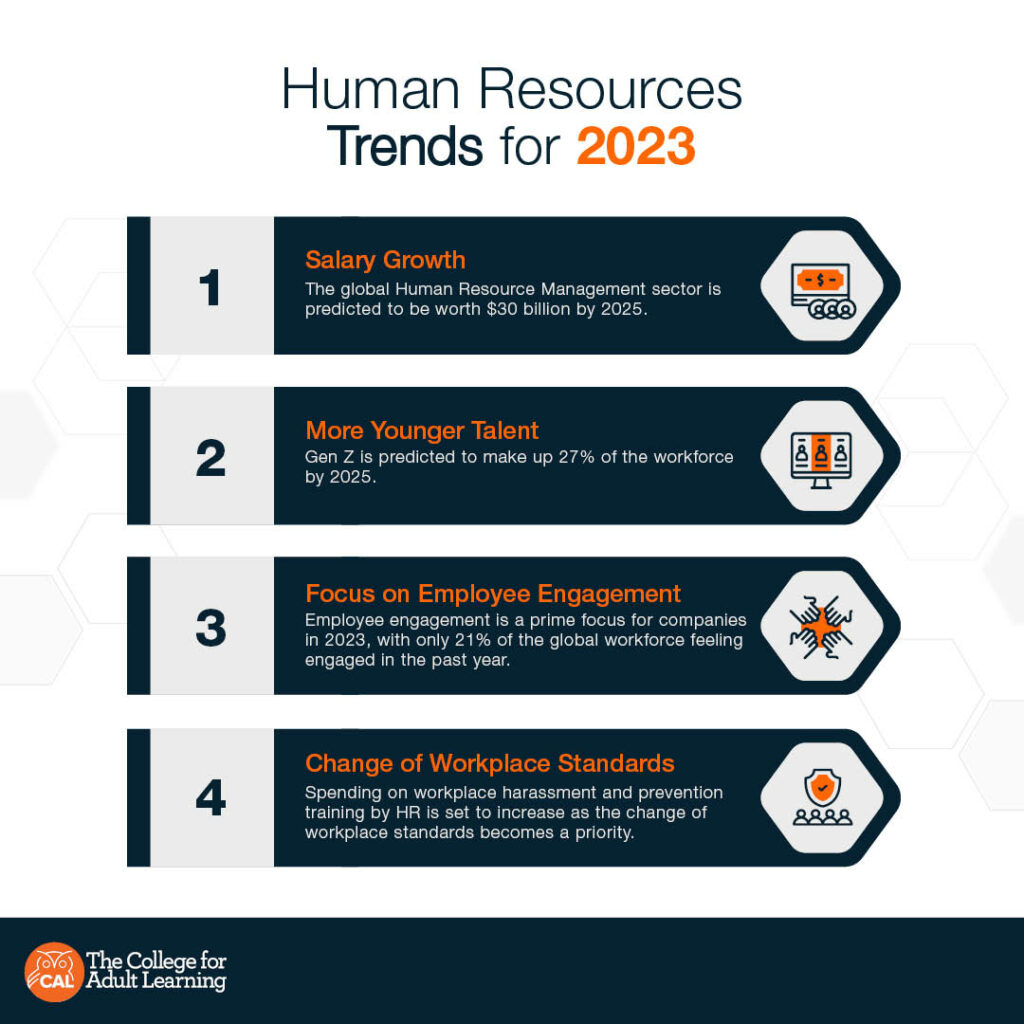
What can you expect on the horizon regarding Human Resources job trends for 2023 and beyond?
A wise business owner knows that employees are by far their greatest asset. Great companies provide workers with an environment in which they’re invested not just financially, but emotionally too. A good Human Resources professional helps facilitate this. Understanding the trending challenges and changes ahead can empower you to confront (and embrace) them in your business.
Continued salary growth
The global Human Resource Management sector is predicted to be worth $56.15 billion by 2030. Entry-level HR professionals in Australia can expect a starting salary of $65,000, with job growth projected at 6% over the next 5 years. However, you’ll need the right qualifications to get there, beginning with a Certificate IV in Human Resource Management (BSB40420).
Meeting demand with supply
The Human Resources sector is a fascinating and rewarding one with a bright future. It’s a simple demand versus supply equation. A recent government study found the need for human resources managers, and training and development managers are growing well above the average workforce demand.
- In 2020, 78,800 Australian professionals were working in the HR industry
- By 2024, growth is estimated to exceed 90,000
Even accounting for job ‘turnover’ where existing workers fill vacancies, that shows a strong upward curve of job growth. Most of those jobs will be full-time positions, which indicates career stability and continuity.
Whether you are already in HR, or keen to enter HR, a long-term career in Human Resources requires a respected qualification. An AHRI-accredited diploma in human resources through the College for Adult Learning is your perfect choice. A qualification that you study at your own pace, to suit your lifestyle, and at a budget-friendly rate is a smart way to ensure you have an edge in the marketplace.
Be trustworthy to attract young talent
Historically, Human Resources practices were built around an assumption of trust: trust in the boss, the process, and technology. Unfortunately, that’s not always the case. Changing jobs is now more normal than not, and young workers are leading the way. Millennials (born from 1981 to 1996) change jobs at a rate three times that of their older colleagues.
46% of job seekers say that company culture is at the forefront of their decision about whether to apply for a job. Then it’s no surprise that companies with a reputation for having their workers’ trust are going to be attractive to a prospective employee.
With Gen Z predicted to make up 27% of the workforce by 2025, it’s also important to understand their unique set of needs and wants in their workplace. This generation values salary less than all the generations before it – instead placing more importance on work/life balance. A good HR manager will know what companies need to offer to attract this younger talent.
Focus on career engagement and development
Employee engagement is a prime focus for companies in 2023. With only 21% of the global workforce feeling engaged in the past year, HR managers and leaders need to make this a priority. Increasingly, employee engagement software is being used to gather and track employee feedback and promote positivity within the workplace. Ongoing training and education, recognition, and career development are the cornerstones of this software. Tailoring individual solutions for each employee is also on the rise, including areas like mental health and overall wellness.

Encouraging workplace tolerance and diversity
Employers are beginning to understand the virtues of diversity in a modern workplace. Selecting your workforce to reflect on the vast social and cultural differences has enormous benefits. Companies that embrace equality at a board level have learned this valuable lesson. A good HR manager will help the company identify any bias (latent or otherwise) and help remove it from the equation.
Driving change in workplace standards
Macquarie Dictionary declared ‘#metoo’ as the 2018 word of the year, but its impact in the workplace will be felt more than ever in 2023 and beyond. Sadly, there’s still a long way to go. The fact is, one in three people has felt sexually harassed in their workplace, and one in two people have been exposed to sexual harassment, either as a victim themselves or as a bystander. As a human resources manager, it’s important to take a strong stance on harassment and bullying in the workplace.
The branding of your culture
Coca-Cola’s logo is not only one of the world’s most recognisable logos, but it also instantly identifies the company as a global leader. Visual branding sets you apart from the pack and can also be applied to small or medium businesses. Focus on the recruitment page of your website, and ‘sell’ the company’s ethos as carefully as you would your product. A business’ mission statement or culture can be more critical to a would-be candidate than the actual business you undertake. After all, research reveals that Millennials would take a $10,000 pay cut in exchange for improved work life.
Overall, Human Resources is shedding its role from tactical to strategic. Everything from board recruitment to technology will be focused on building a happy, healthy workforce where workers arrive to work with a smile on their faces.
Be strategic in your approach to 2023 job trends in Human Resources and act now to stay ahead of the changes. For those ready to start their career in HR, a Certificate IV in Human Resource Management (BSB40420) will allow you the fundamental skills to take on the year ahead and future trends. If you’re ready to grow your career and become a fluent HR manager, start the Diploma of Human Resource Management (BSB50320).
Your Career in Human Resources
Do you want to learn more about HR skills employees demand, the latest emerging job roles and salaries, and recent industry insights?
Discover your career in human resources.
HUMAN RESOURCES CAREER PAGE






